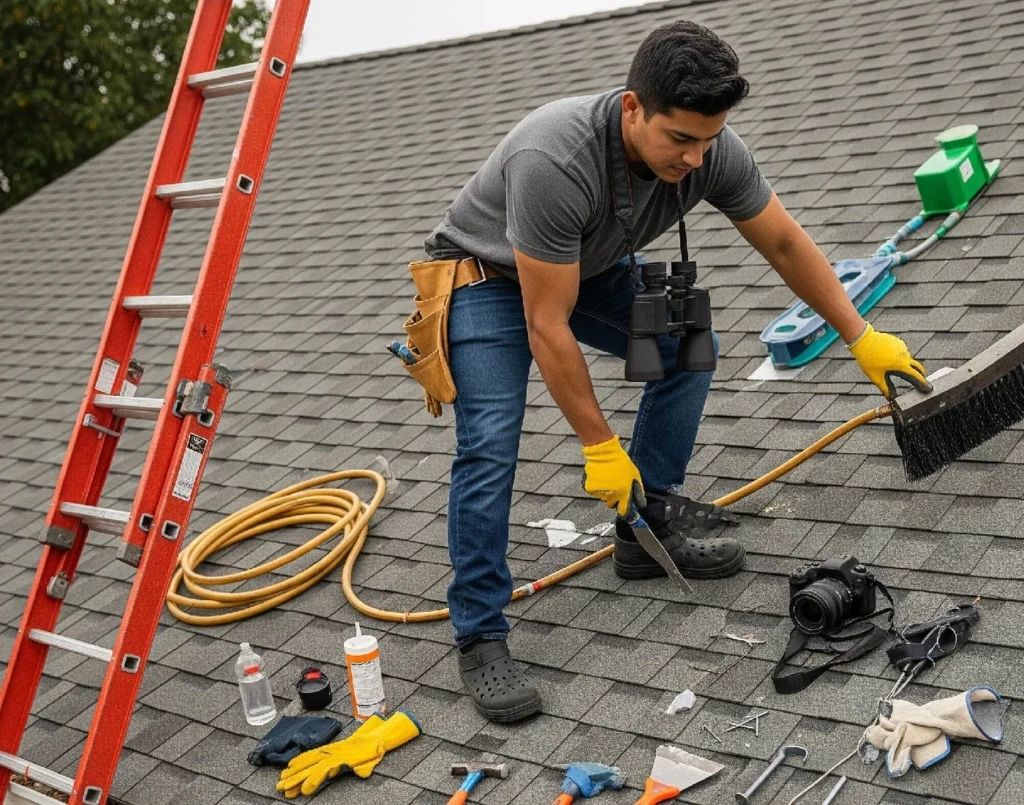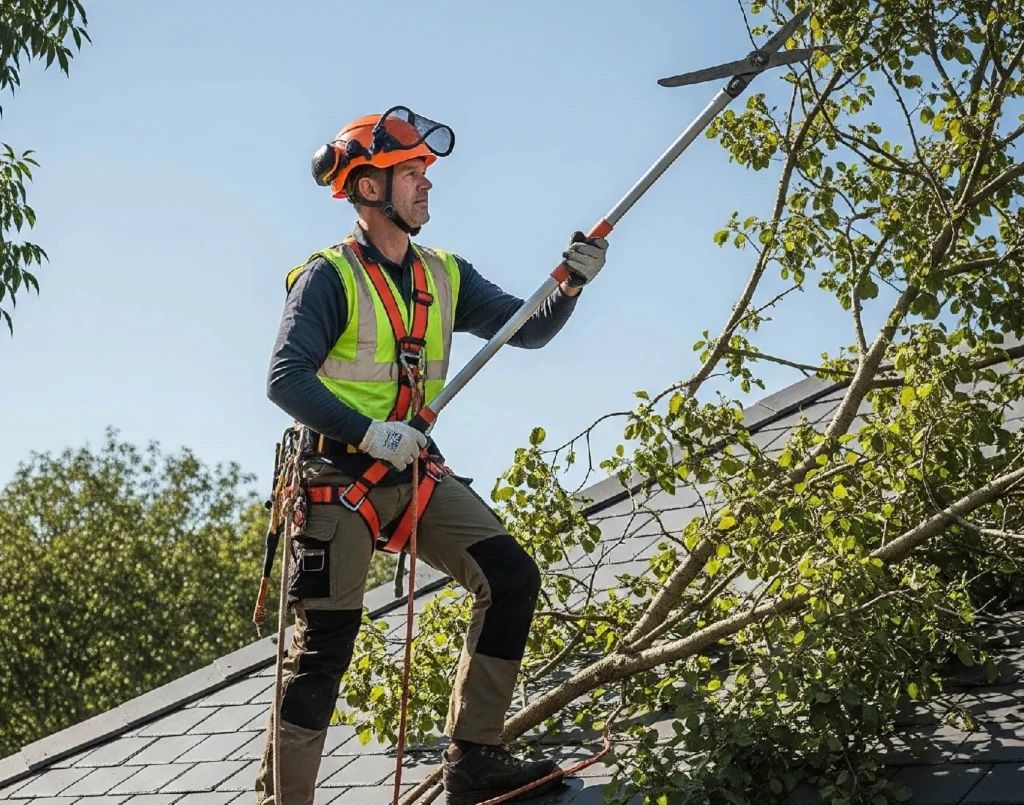- contact@homercareandservices.com
- Mon - Sun: 9:00 - 18:30
Your roof protects your home from bad weather, but if you don’t maintain it, it can turn into a big problem. Roof problems cause water damage, costing homeowners thousands each year. This will cause severe problems like structural harm, mould, and safety risks.
Smart preventive maintenance protects your investment and keeps your family dry. This guide offers simple steps to prevent water damage by caring for your roof. Every day upkeep enables you to avoid emergency upkeep and luxurious recovery fees.
Regular roof checks, clean gutters, and good attic airflow help prevent water damage. Expert care also plays a key role in stopping issues before they start. Inspect shingles for damage. Clear away debris. Trim branches that hang over. Fix small issues before they turn into costly roof repairs. Professional Roof inspections twice yearly catch issues early and extend your roof’s lifespan significantly.

Preventive roof maintenance costs a fraction of major roof water damage repairs. A leaky roof can break insulation, harm electrical systems, and cause mould in your house. Water stains on ceilings often indicate extensive hidden damage that requires professional intervention.
Before starting any roof maintenance, gather these essential items:
⚠️ Never do roof work in wet weather. Call a professional if you’re unsure about safety.
Check your roof tiles and shingles monthly from ground level using binoculars. Look for curled, cracked, or missing pieces that expose the roof deck underneath. Granules collecting in gutters indicate ageing asphalt shingles that need attention.
Walk your home’s perimeter after storms, scanning for loose or displaced materials. Damaged tiles let water in. This can cause leaks and result in structural issues later. Fix shingle issues fast. This stops water from getting into your home’s main defence.
Flashing around chimneys, vents, and roof valleys requires special attention during inspections. Loose or rusty flashing lets water get behind the roof. This can cause hidden harm; it is luxurious to repair.
Look for gaps, rust spots, or separated joints in metallic flashing. Flashing needs to be established flat in opposition to the roof and vertical surfaces. If you need lifting or separation, call a roofing contractor right away. This helps stop water from getting in.
Clogged gutters cause water to back up under the roof edges. This causes ice dams. Clean your gutters twice a year. You can also install gutter guards. They have lower maintenance needs and help with drainage.
Proper roof slope and drainage prevent standing water that accelerates deterioration. Flat or low-slope areas need careful attention. Water can build up and seep through roofing materials, even if they seem intact.
Clear debris from roof surfaces regularly, especially after storms. Moisture gets trapped by leaves, branches, and other debris on roofs. This can lead to rot and leaks. A roof rake helps remove snow buildup that can cause ice dams and structural stress.
But I read that standing water for more than 48 hours is not good, and figured that he didn’t want to fix the slope because it would not be easy. (User r/Roofing)

Tree branches touching or hanging over your roof create multiple problems. Leaves and debris collect in them. They also create paths for pests and can puncture roofs in storms. Heavy branches pose serious risks during high winds, snow, and ice damage.
Branches block air circulation around your roof. This creates damp conditions that lead to algae growth and shingle damage. Regular trimming helps protect your investment. It also lowers the chances of needing emergency roof tarping during storms.
“Do insurance companies assess trees by Google Maps satellite view, drones, drive-by observation, etc.? Not important, just curious.” ( user r/Insurance)
Trim branches to maintain at least six feet of clearance from your roof surface. Hire certified arborists for big branches or trees near power lines. Cutting them wrongly can cause more harm than just leaving them.
Schedule tree trimming before storm seasons to minimize wind damage risks. Properly-maintained bushes beautify your house and even protect your roof. Think about removing trees that drop too much debris or show signs of disease. These issues could harm your home.
Good attic ventilation controls temperature and moisture. This helps your whole roof system. Poor ventilation leads to ice dams in winter and too much heat in summer. These issues can shorten your roof’s lifespan and raise energy costs.
Deploy soffit and ridge vents to create natural airflow from eaves to the roof peak. Attic fans help ventilate homes that lack enough natural airflow. They are especially useful in humid areas where managing moisture is important.
Ensure attic insulation doesn’t block ventilation pathways along the attic floor. Proper insulation placement maintains the attic ceiling’s thermal barrier while allowing air circulation. Balance intake and exhaust ventilation for optimal performance and energy efficiency.
Quality roofing materials resist weather damage and last longer than budget alternatives. Materials, including architectural shingles, metallic roofing, and slate, provide first-rate safety. They help prevent leaks and shield against storm damage.
Consider your local climate when selecting materials. Storm-prone areas need impact-resistant shingles. In places with heavy snowfall, use materials rated for structural loads. Solar panels require additional structural considerations and compatible roofing materials.
Professional installation ensures materials perform as designed and maintains warranty coverage. Skilled roofers know local building codes. They understand proper fastening techniques and waterproofing needs. This knowledge helps prevent future issues.

Schedule roof inspections twice a year. Do this in spring and fall to spot seasonal damage early. Professional assessments find problems homeowners often overlook. This includes structural issues and small signs of wear.
Extra inspections after strong storms help record damage for insurance claims. They also find urgent repair needs. Roofers can check if your roof needs a full replacement or if repairs can help it last longer.
Choose licensed, insured roofing contractors with strong local reputations and current certifications. Verify references and insurance coverage. Also, check if they know your roofing materials and local building codes.
Avoid door-to-door contractors who pressure you for immediate decisions. Reliable pros provide clear estimates in writing, explain their findings simply, and offer references from local roofing projects.
Different seasons require specific maintenance tasks to prevent problems. Get ready for winter. Check your ice dam prevention. Also, ensure your gutters can handle snow melt. Spring inspections focus on storm damage assessment and cleaning winter debris.
Summer maintenance emphasizes ventilation performance and heat damage prevention. Get ready for fall by cleaning your gutters. Check for loose shingles, too. Make sure your roof can handle winter weather.
Regular roof maintenance stops costly water damage and adds years to your roof’s life. Begin with monthly visual checks. Keep gutters clear. Restore small problems earlier than they become huge troubles.
Your roof is your first line of defence. Treat it that way.
🛠 Don’t Wait for the Leak. Act Now. Book a professional roof inspection and build your water damage prevention plan today
Minor roof water damage repairs can range from $500 to $1,500. However, severe problems, like structural damage or mould, may cost over $10,000. Early detection through regular inspections significantly reduces repair costs.
Sure. Easy gutters save water from backing up beneath shingles and into your roof deck. Clogged gutters are a major cause of roof leaks and ice dams. Cleaning them twice a 12 months ensures the right water flow and roof safety.
Call a roofer right away if you notice:
These may signal serious underlying problems that DIY solutions can’t fully resolve. Don’t wait for the damage to worsen.
Yes, you may use roofing tape or sealant temporarily for minor leaks. However, DIY repairs often miss hidden issues like faulty flashing or soaked insulation. It’s best to let a professional assess the extent of the leak.
Not always. Some leaks are caused by isolated issues like cracked flashing or damaged shingles. If the overall structure is sound, targeted repairs may be enough. However, substitutes may be more fee-powerful if leaks are common and great.